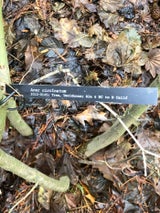- Plant IDs
- >
- ID By Type
- >
- Trees
- >
- Deciduous Trees
- >
- Maples (Acer)
- >
- Acer circinatum
Acer circinatum
Common name: Vine maple
Acer circinatum, a species closely related to Acer palmatum, is the smallest of the maples native to western North America. It can often be found growing along stream beds and in moist woods from southwestern British Columbia to northern California, usually within three hundred kilometres of the Pacific Ocean. Landscapers think that it is one of the most popular native shrubs for landscapes.
A. circinatum can often be found as an understory shrub, growing under trees such as douglas-fir, western hemlock, western red cedar, and Sitka spruce. In sunny locations A. circinatum will grow upright, but when in shade it will take on a horizontal habit. The tree can grow almost horizontally touching the ground and rooting to make new colonies. David Douglas wrote that the voyageurs called it 'bois de diable' or 'tree of the devil' because of the stems rooting and creating impenetrable thickets.
A. circinatum leaves are almost circular in shape, and have seven to nine toothed lobes. They are yellowish-green above, and pale green and downy on the underside. Full sun will bring on brilliant fall colour in shades of orange and red, while dappled light will produce leaves of golden yellow. The fruit, a winged samara, is wide-spreading, almost in a straight line.
Vine maple was collected by the Lewis and Clark expedition and introduced to Europe in 1826 by David Douglas. The species name circinatum means 'rounded, referring to the shape of the leaves.
A. circinatum is an important tree for wildlife. It provides food and shelter for birds and mammals.
Due to the flexibility of the wood, First Nations people used A. circinatum to make snowshoe frames, drum hoops, and small tools. The thin branches were used to weave baskets and make fish traps. As well, it was often used for firewood.
Acer circinatum can be found in various locations throughout the garden. The Garden photos were taken in Bed 118 and 135C of the Canadian Heritage Garden, and in Bed 23B of the Cascadia Garden the winter of 2023.
Text by Kumi Sutcliffe
Fall colour photo by John Rusk, via Wikimedia Commons
Flower photo by Walter Siegmund, via Wikimedia Commons
Shrub photo El Grafo, via Wikimedia Commons
Other photos in the Garden by Kumi Sutcliffe









